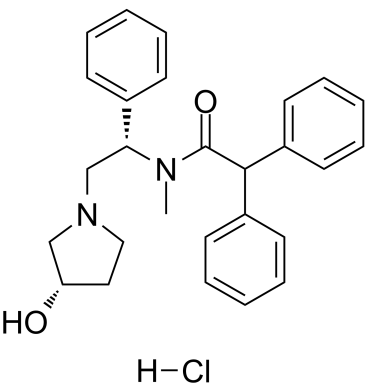Asimadoline hydrochloride |
| Katalog-Nr.GC61397 |
Asimadolin (EMD-61753) Hydrochlorid ist ein oral aktiver, selektiver und peripher aktiver κ-Opioid-Agonist mit IC50-Werten von 5,6 nM (Meerschweinchen) und 1,2 nM (human rekombinant).
Products are for research use only. Not for human use. We do not sell to patients.

Cas No.: 185951-07-9
Sample solution is provided at 25 µL, 10mM.
Asimadoline (EMD-61753) hydrochloride is an orally active, selective and peripherally active κ-opioid agonist with IC50s of 5.6 nM (guinea pig) and 1.2 nM (human recombinant). Asimadoline hydrochloride has low permeability across the blood brain barrier and has peripheral anti-inflammatory actions. Asimadoline hydrochloride ameliorates allodynia in diabetic rats and has the potential for irritable bowel syndrome (IBS)[1][2][3].
Asimadoline (EMD-61753) hydrochloride has high selectively in κ: μ: δ opioid binding ratios of 1:501:498 in human recombinant receptors. The IC50 for Asimadoline hydrochloride binding to μ-opioid receptors is 3 µM and to δ-opioid receptors is 0.7 µM. The IC50 values for D1, D2, kainate, σ, PCP/NMDA, H1, α1, α2, M1/M2, glycine, 5HT1A, 5HT1C, 5HT1D, 5HT2, 5HT3, AMPA and kainate/AMPA receptors are all >10 µM[1]. Asimadoline hydrochloride has affinity to sodium and L type Ca2+ ion channels at IC50 concentrations 150 to 800 fold the IC50 for the κ receptors[1]. At high concentrations, Asimadoline hydrochloride demonstrates spasmolytic action against 400 µM barium chloride in the rat duodenum (IC50=4.2 µM), suggesting that Asimadoline hydrochloride may block the direct stimulant effects of barium on smooth muscle through mechanisms that are not identified[1].
Asimadoline (EMD-61753 hydrochloride; 1, 5, 15 mg/kg; s.c.) acutely ameliorates both formalin-evoked hyperalgesia and tactile allodynia in diabetic rats[3].The absorption rate following oral administration is 80% in rats and >90% in dogs and monkeys. The metabolism of Asimadoline hydrochloride is rapid and appears similar in animals and man. Asimadoline hydrochloride has peripheral anti-inflammatory actions that are partly mediated through increase in joint fluid substance P levels[1]. Treatment with Asimadoline hydrochloride (5 mg/kg/day; i.p.) produces marked (and sustained) attenuation of the disease with all three time regimes[2]. Animal Model: Adult female Sprague-Dawley rats[3]
[1]. Camilleri M, et al. Asimadoline, a κ-Opioid Agonist, and Visceral Sensation. Neurogastroenterol Motil. 2008 Sep; 20(9): 971-979. [2]. Binder W, et al. Involvement of substance P in the anti-inflammatory effects of the peripherally selective kappa-opioid asimadoline and the NK1 antagonist GR205171. Eur J Neurosci. 1999 Jun;11(6):2065-72. [3]. C G Jolivalt, et al. Dynorphin A, kappa opioid receptors and the antinociceptive efficacy of asimadoline in streptozotocin-induced diabetic rats. Diabetologia. 2006 Nov;49(11):2775-85.
Average Rating: 5 (Based on Reviews and 1 reference(s) in Google Scholar.)
GLPBIO products are for RESEARCH USE ONLY. Please make sure your review or question is research based.
Required fields are marked with *




















